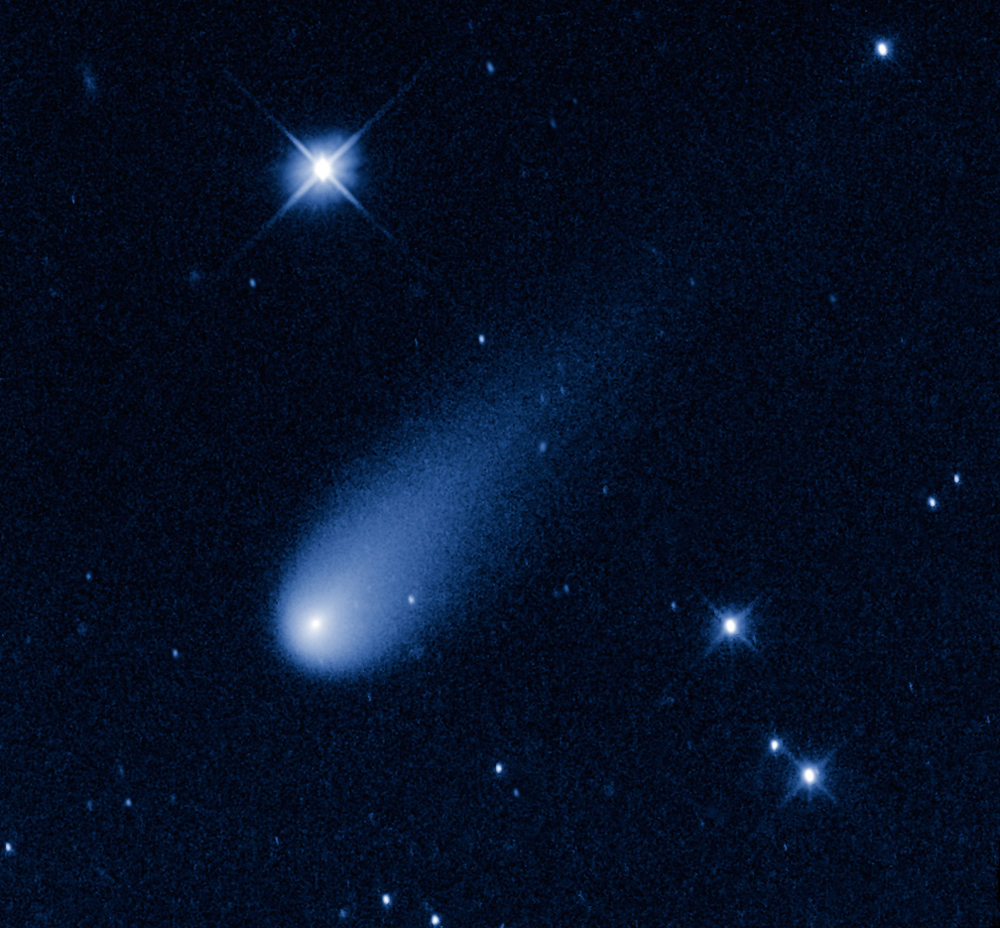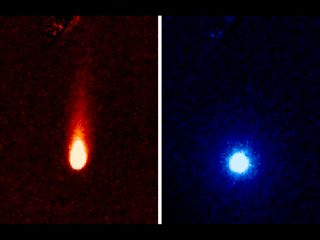Mighty Comet ISON: Space and Earth Telescopes to Track 'Comet of the Century'

LAUREL, Md. — All eyes on the sky that can do so will be pointing toward Comet ISON soon, as a massive international observing campaign gets underway to watch what could become the "comet of the century," scientists say.
Comet ISON was discovered in September 2012, and is due to swoop in close to the sun in November. When it does, it may become as bright as the full moon, visible to the naked eye even in daylight. Or, it may not.
What will happen to Comet ISON is an open question to scientists, who hope to learn more about what causes certain comets to flare brightlyand others to fizzle out and evaporate under the sun's radiation. [Photos of Comet ISON: A Potentially Great Comet]
Uncertain fate
"We don't have anything to directly compare to ISON," astronomer Matthew Knight of the Lowell Observatory in Flagstaff, Ariz., said Thursday (Aug. 1) here at the Johns Hopkins University Applied Physics Laboratory during a two-day workshop on observing ISON. Based on historical records, he said, very large comets tend to survive their encounters with the sun, while smaller ones evaporate or break into pieces under the harsh solar radiation. Comet ISON is a mid-sized comet, and its fate is very uncertain.
ISON is thought to originate in the Oort cloud, a large spherical cloud of small planetary fragments that is thought to surround the sun and extend up to a light-year out. The comet was first discovered in September of 2012, and belongs to a class of bodies called sungrazing comets that skim in close to the sun's atmosphere.
Under the banner of a coordinated observing program called the NASA Comet ISON Observing Campaign, dozens of observatories on the ground, in space, and even on sounding rockets and high-altitude balloons, will watch the comet's progress toward the sun this fall.
Get the Space.com Newsletter
Breaking space news, the latest updates on rocket launches, skywatching events and more!
Starting at Mars
One of the first major series of observations will be taken from orbit around Mars, which will have a view of ISON as it moves toward the inner solar system. NASA's Mars Reconnaissance Orbiter (MRO), plans to snap photos of ISON on Aug. 20, when the comet makes its closest approach to the Red Planet.
"The Aug. 20 observations might give you all an early indication of just how bright the comet has become, at least at this time and place," said Richard Zurek, chief scientist of the Mars Program Office at NASA's Jet Propulsion Laboratory in Pasadena, Calif. [Comet ISON: Evolution of a Potentially Great Comet (A Timeline)]
In addition to MRO, NASA's Mars rovers Curiosity and Opportunity will try to take photos of Comet ISON as it appears in the Martian sky overhead.
After ISON zooms by Mars, it will soon approach Mercury, the innermost planet in the solar system. There, NASA's Messenger probe orbiting the tiny planet will make observations of the comet.
And finally, as it nears the sun, three solar observatories will switch into high gear mode to watch ISON rendezvous with our star, where it will make its closest approach on Nov. 28. NASA's SOHO (Solar & Heliospheric Observatory), STEREO (Solar TErrestrial RElations Observatory) and SDO (Solar Dynamics Observatory) spacecraft will all turn their sights on the possible "comet of the century."
Observing throughout the spectrum

Space telescopes that specialize in observing through certain wavelengths of light will each have their special roles to play in the campaign. NASA's Swift satellite will photograph ISON in gamma-ray light, while the Spitzer Space Telescope will observe in infrared light and the Chandra Observatory will look in X-rays.
Not to be outdone, dozens of telescopes on the ground will also contribute to observations of Comet ISON, including the Lowell Observatory, the Arecibo radio dish in Puerto Rico, and the Submillimeter Array in Hawaii, just to name a few.
This coordinated effort will help scientists catch ISON in action, as its transformation during its close encounter with the sun could be rapid.
"ISON isn't up for very long in any one area — not enough to characterize it," Knight said. "We'd like to combine observations from around the world — as many longitudes as we can get — and collect them all. You get roughly 24-hour coverage. From that we may be able to piece together what's going on."
Dedicated missions
While many observatories will be diverting from normal work to observe ISON, some missions have been designed for this comet specifically.
One project is a small sounding rocket mission dubbed FORTIS (Far-ultraviolet Off Rowland-Circle for Imaging and Spectroscopy) that will measure ultraviolet light from Comet ISON during a short 5-6 minute observing window while the rocket flies up to the edge of space and back.
Another mission dedicated to ISON is the BRRISON (Balloon Rapid Response for ISON) mission, which will loft a telescope on a high-altitude balloon designed to travel 120,000 feet (37,000 meters) up to Earth's stratosphere, where it can observe in infrared and near ultraviolet/visible wavelengths.
"I don't need to tell this audience why ISON is such an unusual opportunity," said BRRISON's principal investigator, Andrew Cheng of the Applied Physics Laboratory. "It's a sungrazer, unusually bright, it's also an Oort cloud comet, probably on its first visit to the inner solar system, preserving icy material that was formed in the very early days of our solar system."
Follow Clara Moskowitz on Twitter and Google+. Follow us @Spacedotcom, Facebook and Google+. Original article on SPACE.com.
Join our Space Forums to keep talking space on the latest missions, night sky and more! And if you have a news tip, correction or comment, let us know at: community@space.com.

Clara Moskowitz is a science and space writer who joined the Space.com team in 2008 and served as Assistant Managing Editor from 2011 to 2013. Clara has a bachelor's degree in astronomy and physics from Wesleyan University, and a graduate certificate in science writing from the University of California, Santa Cruz. She covers everything from astronomy to human spaceflight and once aced a NASTAR suborbital spaceflight training program for space missions. Clara is currently Associate Editor of Scientific American. To see her latest project is, follow Clara on Twitter.










